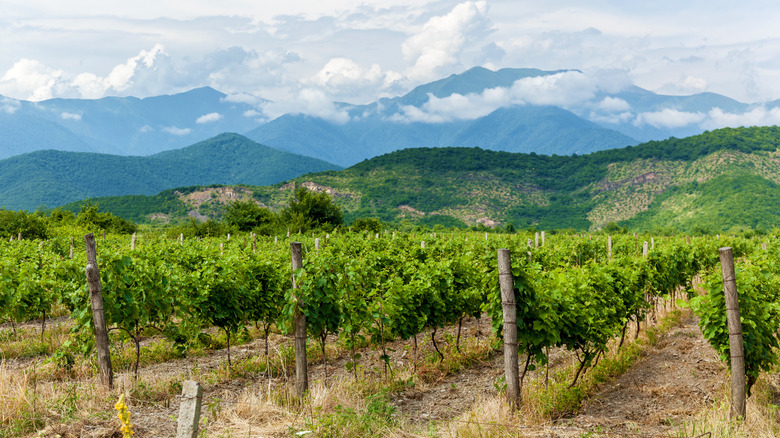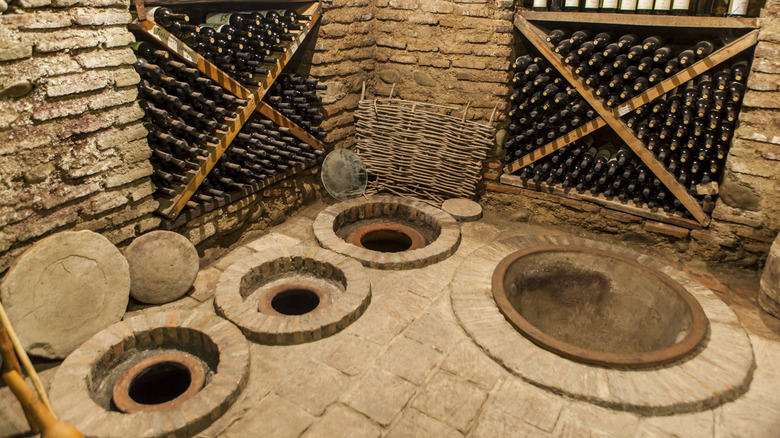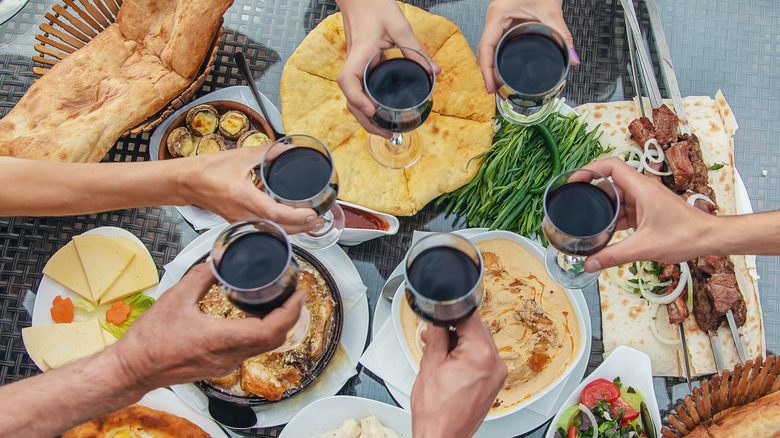The Birthplace Of Wine Is In This Unexpected Country
Imagine sharing a bottle of wine with friends when someone asks, "Where was wine invented?" Some confidently claim France, while others believe it is Italy. However, they'd both be wrong because the birthplace of wine is a country you wouldn't expect.
The answer lies in Georgia — not the American state, but the small country at the intersection of Asia and Europe. Nestled in the Caucasus Mountains, Georgia is one of Europe's most beautiful mountainous countries. It's also the site of the oldest evidence of winemaking in history. According to ScienceDaily, archeologists from the Gadachrili Gora Regional Archaeological Project Expedition discovered ancient vessels containing wine residue dating back 8,000 years. This finding confirms what Georgians have been boasting for generations: that they are the pioneers of winemaking. As such, it's probably no coincidence that the words "wine" and "vino" are strikingly similar to the Georgian word "ghvino."
Georgia may be called "the Cradle of Wine," but this fermented beverage isn't merely a thing of the past. The country's winemaking tradition is evident everywhere you go. You'd be hard-pressed to sit down for a Georgian meal without being offered wine. Even the symbolic Mother of Georgia statue is holding wine in one hand. And truthfully, if you haven't tried Georgian wine, you're missing out. So let's journey through Georgia's past to understand how its winemaking roots grew into a vibrant cultural phenomenon.
The history of Georgian wine
Georgia's claim to fame isn't just having the oldest winemaking tradition — it's the country's distinctive approach that sets it apart. Those ancient clay vessels that were discovered? They were the predecessors of today's qvevri, specialized clay vats used to ferment wine. This qvevri wine-making method, now recognized on UNESCO's list of Intangible Cultural Heritage, has been passed down through generations. Families gather to pick and press grapes before pouring the mixture of juice, skin, and stocks into qvevri buried underground. After the concoction ferments for roughly six months, Georgians enjoy the fruits of their labor.
This winemaking tradition has weathered several storms throughout history. Georgia's strategic location has made it a target for various empires, often forcing locals to flee or relocate. However, local legend has it that Georgians hid grape saplings during invasions to protect their precious vines — not merely to save their favorite drink but because wine is an integral part of their cultural identity.
When the Soviets took control of Georgia, they also nationalized its vineyards, prioritizing efficiency over tradition. Instead of cultivating a vast array of grapes, farmers focused on those with the highest yield. However, Georgia's independence in 1991 changed everything. Farmers were free to repopulate grape varietals of their choosing, giving new birth to Georgia's wine culture. Since then, ongoing local initiatives have aimed to resurrect hundreds of grape varietals lost during the Soviet Era — and thanks to individuals who maintained vines in their backyards during Soviet rule, Georgia now proudly cultivates over 500 indigenous grape varieties.
Georgian wine today
In Georgia, winemaking remains deeply personal, and most families still produce wine for their own enjoyment. Pitchers of wine are typically shared at feasts referred to as "supras." These lively events are hosted by a "tamada," or toastmaster, who guides the celebration with heartfelt toasts throughout the meal.
Meanwhile, Georgia's commercial wine industry is equally important. There are several wine regions, with Kakheti being the most popular. Kakheti is one of Europe's most underrated wine regions, meaning you won't encounter swarms of crowds. And although wine tourism is a year-round event, the best time to visit is the harvest season. This period, from late September to mid-October, is when tourists can witness the qvevri winemaking process firsthand. However, Georgians don't solely depend on the qvevri method these days. The wine industry has evolved to include modern techniques and international styles.
Georgia is an under-the-radar wine region that is different from the rest. Here, you'll encounter varieties you've never heard of, with completely unique flavors. The most well-known Georgian wine is Saperavi, a dry red with a robust profile and smooth aftertaste. However, Georgia's semi-sweet reds, including Kindzmarauli and Khvanchkara, are particularly delicious. White wine enthusiasts will appreciate the crisp Rkatsiteli and Mtsvane, or their elegant blend, Tsinandali. And long before amber wine became trendy worldwide, it was a Georgian specialty. Whichever wine you choose, make sure to raise a glass and toast to the birthplace of wine — and, as the locals would say, "gaumarjos!"


